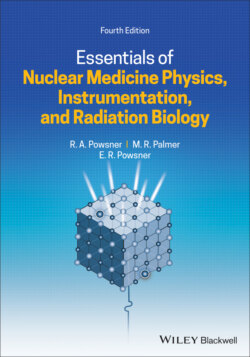Читать книгу Essentials of Nuclear Medicine Physics, Instrumentation, and Radiation Biology - Rachel A. Powsner - Страница 37
Decay notation
ОглавлениеDecay from an unstable parent nuclide to a more stable daughter nuclide can occur in a series of steps, with the production of particles and photons characteristic of each step. A standard notation is used to describe these steps (Figure 1.21). The uppermost level of the schematic is the state with the greatest energy. As the nuclide decays by losing energy and/or particles, lower horizontal levels represent states of relatively lower energy. Directional arrows from one level to the next indicate the type of decay. By convention, an oblique line angled downward and to the left indicates electron capture; downward and to the right, beta emission; and a vertical arrow, an isomeric transition. The dogleg is used for positron emission. A dogleg with a “Z” denotes alpha decay. Notice that a pathway ending to the left, as in electron capture or positron emission, corresponds to a decrease in atomic number. On the other hand, a line ending to the right, as in beta emission, corresponds to an increase in atomic number.
Figure 1.19 Isomeric transition. Excess nuclear energy is carried off as a gamma ray.
Figure 1.20 Internal conversion. As an alternative to gamma emission, it can lead to emission of either an X‐ray (a) or an Auger electron (b).
Figure 1.22 depicts specific decay schemes for 99mTc, 111In, 131I, and 226Ra (this is not the isotope used for treatment in nuclear medicine, 223Ra, which will be discussed in detail in Chapter 18). The “m” in 99mTc stands for metastable, which refers to an excited nucleus with an appreciable lifetime (>10–12 seconds) prior to undergoing isomeric transition.
